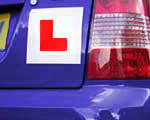 Go to main content
Go to main content
Archive Website of the UK government
Please note that this website has a UK government accesskeys system.
Main menu
Page menu
Motoring

Driving eyesight requirements

Before you start to learn to drive, make sure you know the eyesight rules. If you need to wear glasses or contact lenses to meet the requirements, you must wear them every time you drive. Find out what the rules say and how your eyesight is tested.
If you have an eyesight condition
When you apply for your driving licence, you must tell the Driver and Vehicle Licensing Agency (DVLA) if you have any visual condition which affects:
- both eyes - not including short or long sight or colour blindness
- your sight - not including short or long sight or colour blindness - for example, if you have sight in one eye only
If you have had sight correction surgery
If you have had sight correction surgery you should declare this when you apply for your provisional licence.
Find out if you need to tell DVLA about your condition
You can search the medical conditions A to Z to see if you need to tell DVLA of your visual condition.
The practical driving test eyesight test
How the test works
You have to correctly read the number plate on a parked vehicle - you get up to three chances to get it right
At the start of the practical driving test, your driving examiner will ask you to read the number plate on a parked vehicle.
You'll have to read the number plate from a distance of:
- 20 metres for vehicles with a new-style number plate
- 20.5 metres for vehicles with an old-style number plate
New-style number plates start with two letters followed by two numbers, for example AB51 ABC.
If you can't speak English or have difficulty reading, you can write down what you see.
If you can't read the first number plate
If you can't read the first number plate correctly, you'll be asked to read a second number plate.
If you can't read the second number plate
If you can't read the second number plate correctly, the examiner will measure the distance to a third number plate. This is your final chance to read a number plate correctly.
If you can't read the third number plate
If the examiner is satisfied that you don't meet the required eyesight standard:
- you'll fail your driving test
- your driving test will not continue
What happens if you fail the eyesight test
If you fail the eyesight test:
- the examiner will ask you to sign a form stating you were unable to comply with the eyesight requirements
- DVLA will be told that you did not meet the eyesight requirements
- your licence will be revoked
How to reapply for your licence
To reapply for your licence, send an 'Application for a driving licence' (D1) to DVLA. The form is available from the DVLA form ordering service or Post Office® branches. You can also download and complete the medical questionnaire V1 and return it with your D1 form.
What happens when DVLA gets your application
When your application arrives at DVLA they may ask the Driving Standards Agency (DSA) to conduct a separate eyesight test for you. This will be at a driving test centre. If you are successful you’ll still have to pass the DSA standard eyesight test at your next practical driving test.
Wearing glasses or contact lenses while driving
 What the law says
What the law says
If you wear glasses or contact lenses for the eyesight test, the law requires that you wear them whenever you are driving
If you wear glasses or contact lenses for the eyesight test, the law requires that you wear them whenever you are driving. This includes during your driving test.
Wearing glasses or contact lenses during your test
You are not allowed to remove your glasses or contact lenses when carrying out test manoeuvres (reversing and so on).
If you wear glasses or contact lenses to read the number plate and remove them during the test, you'll be reminded you must wear them. If you refuse to wear them, the test will not continue.
If you don't bring your glasses to your test
If you have broken, forgotten or brought the wrong glasses, tell your examiner at the start of the test. If you don't tell the examiner and you attempt and fail the eyesight test, your test will be recorded as a failure. The rest of the test will not go ahead.
Additional links
Simpler, Clearer, Faster

From 17 October, GOV.UK will be the best place to find government services and information

